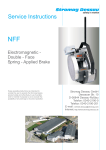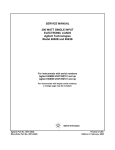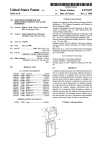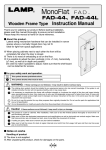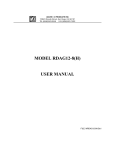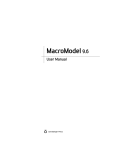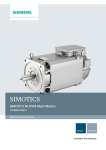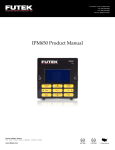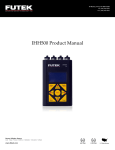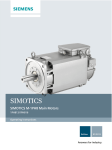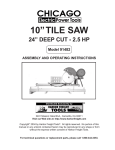Download 4 BZFM
Transcript
Stromag Dessau safety in motion Service Instruction 4 BZFM ElectromagneticDouble - Face Spring - Applied Brake These operating instructions are intended to enable the user to operate the Stromag Dessau product safely and effectively, to use it sensibly and to maintain it properly so as to exclude the possibility of any damage or incorrect operation. Stromag Dessau GmbH Dessauer Str. 10 D-06844 Dessau-Roßlau Telefon: 0340-2190-0 Telefax: 0340-2190-201 E-mail: [email protected] Internet: http://www.stromag-dessau.de Stromag Dessau Service Instructions 4 BZFM IP 67 (IP 66) safety in motion Electromagnetic Double - Face Spring - Applied Brake 01.06.2009 Contents Chapter Page Technical data Nameplate data Torque, speed, and other technical data Bore and keyway dimensions, connections Application and utilization as per specification 1 1.1 1.2 1.3 1.4 2 2 2 3 3 Safety guidelines Symbol for safety at work Instructions “Caution” Safety instructions for working Electromagnetic compatibility 2 2.1 2.2 2.3 2.4 4 4 4 4 5 Transportation Packing Pre-mounting condition Sensitivity In – process stocking Delivery extent 3 3.1 3.2 3.3 3.4 3.5 5 5 5 5 6 6 Construction, functioning, construction characteristics Designation of individual components Function and design characteristics of the standard version Mechanical release by means of emergency release screws Current supplies and electrical connections 4 4.1 4.2 4.3 4.4 6 6 7 7 8 Assembly and dismantling Assembly Direct assembly Mounting via intermediate flange Mounting accuracy Dimensions, space requirement and mass Dismantling 5 5.1 5.1.1 5.1.2 5.2 5.3 5.4 8 8 8 8 9 9 9 Initial setting into service 6 9 Operation Operating conditions Protection classes Duty cycle, switching frequency and times Trouble shooting 7 7.1 7.2 7.3 7.4 10 10 11 12 12 Maintenance Maintenance and inspection works Measurement of the air gap Wear re-adjustment Replacement of the friction disc 8 8.1 8.2 8.3 8.4 13 13 13 13 14 Variants (optional) Execution with micro switch Execution with standstill heating Speedometer installation 9 9.1 9.2 9.3 15 15 15 16 Spare parts stocking, after-sales service Spare parts stocking Data for spare parts stocking Address of after-sales service 10 10.1 10.2 10.3 16 16 17 17 Listed standard and regulations 11 18 Appendix 12 19 1 Stromag Dessau Service Instructions 4 BZFM IP 67 (IP 66) safety in motion Electromagnetic Double - Face Spring - Applied Brake 1 Technical data 1.1 Nameplate data 01.06.2009 The following data is stated on the nameplate. It is provided on the front side of the brake. Type Article code Serial nr. Nominal torque Nominal voltage Idling speed switching speed Nominal current nominal braking capacity Air gap “on” Air gap “off” Thermical class Protection classes Mass Nm V DC min-1 A kW mm mm kg This data must comply with the identifications of the order acknowledgement. 1.2 Torque, speed, and other technical data table 1 Size 4 BZFM 6,3 10 16 25 40 63 100 160 250 400 Mdyn Nm 63 100 160 250 400 630 1000 1600 2500 4000 Mstat Nm 69 110 175 275 440 690 1100 1750 2750 4400 n0 min-1 6000 6000 6000 5500 4700 4000 3600 3200 2800 2400 nzn Un * min-1 V-DC 3300 110 3000 110 2700 110 2100 110 1800 110 1500 110 1300 110 1100 110 1000 110 1000 110 Pk W 110 122 142 164 214 249 332 403 530 675 * other voltages on request 2 Airgap min/max 0,4/1,2 0,4/1,2 0,4/1,2 0,4/1,2 0,4/1,5 0,4/1,8 0,5/2,1 0,5/2,4 0,5/2,8 0,5/2,8 W kJ 80 100 120 150 220 300 350 400 590 698 PVN J kW kgcm2 0,16 12 0,21 19 0,26 26 0,31 50 0,38 133 0,46 271 0,57 366 0,7 600 0,85 1266 0,85 2670 m kg 23 32 40 60 73 98 135 205 275 380 Stromag Dessau Service Instructions 4 BZFM IP 67 (IP 66) safety in motion Electromagnetic Double - Face Spring - Applied Brake 01.06.2009 Mdyn dynamic torque (friction torque, nominal value for working brake) applies to dry operation with an oil- and grease-free friction lining after running-in Mstat static torque (torque of adhesion) no maximum idling speed nzn nominal switching speed Pk excitation output at 20°C Pvn nominal braking capacity (S4-40% I.O.) W switch work per switching operation for z = 1-5 h-1 J mass moment of inertia of rotating parts m weight with smallest flange Protection class IP 67 in accordance with DIN 40050 in the installed state Mode of operation S1, S2, S4 - 40% I.O. Thermical class 155 (F) in accordance with DIN VDE 0580 AC control via rectifier with the modules type BG 270, EGV 500 The main parameters of the brakes are also given on the identification plate. Admissible torques and other technical data are given in table 1. Any technical parameters deviating from the values given in the table may be requested from the manufacturer or form part of the order acknowledgement. 1.3 Bore and keyway dimensions, connections The connecting dimensions correspond to the IEC standard and DIN 42948, the fitting key dimensions to DIN 6885 sheet 1. 1.4. Field of application and utilization as per specification a) on ships on deck at gypsy winches, windlasses, shipboard cranes, cargo winches and trawler winches. b) in docks in harbour cranes, container loading facilities for crane, hoisting and trolley travel gears. c) in rolling mills, metallurgical factories, cement mills and in mining. Operating conditions: Protection class IP 67 in accordance with DIN 40050 (VDE 0470) protected against water jets and flooding. Electrical design of brakes in accordance with DIN VDE 0580 in thermical class 155 (F). The brake corresponds to Directive 93/68/EEC (Low Voltage Directive). The Directive 89/336/EEC (EMC) must be ensured by the user, taking into account the instructions given by the manufacturer. The products are marked accordingly. Mode of operation S1, S2, S4. Horizontal installation. Vertical operation after consultation with manufacturer. 3 Stromag Dessau Service Instructions 4 BZFM IP 67 (IP 66) Electromagnetic Double - Face Spring - Applied Brake safety in motion 01.06.2009 With the friction combination steel/ organic friction lining the brake may only be used for dry running under the conditions described in Chapters 7.1 and 7.3. In addition, compliance with the assembly, dismantling, commissioning and maintenance conditions specified by the manufacturer must be ensured. Non-compliance with these conditions or any use beyond this shall be deemed use not in accordance with the specification. The manufacturer shall not be liable for any such use, the risk shall be exclusively borne by the user. If the brake is to be used outside this contractual scope of operation, contact Stromag Dessau for further details (Address see Chapter 10.3). 2 Safety guidelines 2.1 Symbol for safety at work This symbol denotes all the safety instructions in this manual which deal with danger to life and limb of personnel. These instructions must be adhered to and particular caution exercised in these cases. All users must be familiarised with the safety instructions. 2.2 Instructions Caution! The term "Caution!" denotes those sections in this manual which require special attention, in order that the guidelines, recommendations and correct procedures are complied with to prevent damaging or destroying the brake. 2.3. Safety during operation The following recommendations are of particular importance: The brake has been manufactured to the highest up to date standard and is operationally safe. However, the brake can become a risk to safety when used improperly by untrained personnel or for an application it is not designed for. Every person involved in assembling, disassembling, commissioning, operating and maintaining (inspecting, servicing and repairing) the brake must be authorised, adequately trained and instructed. Each such person must have read and understood this instruction manual, especially in respect to the safety instructions. We do not accept liability for damage or malfunctioning, resulting from non - adherence to this manual. Repair and maintenance works must be carried - out by skilled and trained workmen only meeting the minimum requirements for aptitude and qualification according to DIN VDE 1000-10. Any work process involving the brake which impairs safety is to be avoided. The user is obliged to inform the supplier immediately of any change occurring to the brake which adversely affects safety; address see chap. 10.3. The user is obliged to only operate the brake when it is functioning correctly. Unauthorised changes and modifications which impair safety, as well as the use of non - authentic components are not permitted. To exclude any danger to people, domestic animals and goods by parts in motion, the user has to take protective measures according to DIN 31000 / VDE 1000. 4 Stromag Dessau Service Instructions 4 BZFM IP 67 (IP 66) Electromagnetic Double - Face Spring - Applied Brake safety in motion 01.06.2009 As protection against hazardous shock currents, the user has to take protective measures according to DIN VDE 0100 - 410 and DIN EN 50274. To avoid dangerous influences due to heating of the units and in case of a failure, the user has to take suit-able protective measures according to DIN 31000 / VDE 1000 and DIN VDE 0100 - 420. To exclude any danger to people, domestic animals and goods by direct or indirect effect of electromagnetic fields, the user has to take suitable measures according to DIN V VDE V 08484/A3. Caution! In every case the local safety and accident prevention regulations are also applicable, the user must ensure that these are complied with. We reserve the right to make modifications of a technical nature to this manual if required for brake development. We recommend that these instructions are incorporated into the service manual of the user (machine manufacturer). 2.4 Electromagnetic Compatibility The Electromagnetic Compatibility of Equipment Act (EMVG) demands to meet defined protective requirements when using electrical equipment so that this equipment can operate in its electromagnetic environment without mutual impairment of function. Machine manufacturers, system and plant constructors must assure that the product is installed as required and that the installation of the pertinent current supply is made correctly in order to adhere to the protective requirements of the EMVG. Please inquire our leaflet "EMC - notes", No. 900 - 00001 at Stromag Dessau GmbH; address as per chap. 10.3. 3 Transportation 3.1 Packing The type of packing complies with the agreements with the orderer as stated in the order acknowledgement. If no type of packing has been agreed, it depends on the transportation route. The symbols marked on the packing must be adhered to. 3.2 Pre-mounting conditions The brakes will be supplied completely mounted and with all settings made. The pinion (05) is supplied as a loose part. The sealing ring (31) according to figure 1 will be supplied as a loose part. The user shall select the fastening screws in accordance with the flange thickness and the counterpart. 3.3 Sensitivity Caution! Make sure to avoid damage as a result of shocks or impacts during transportation. Special care should be exercised with regard to the axial connecting cable. For direct transportation and assembly of the brake there is a support hole in the cover (11), see figure 1. 5 Stromag Dessau Service Instructions 4 BZFM IP 67 (IP 66) safety in motion Electromagnetic Double - Face Spring - Applied Brake 01.06.2009 Caution! The support hole shall not be used for transport and for mounting of the unit motor and flanged brake. Make sure to avoid the generation of condensation water as a result of strong temperature fluctuations. 3.4 In - process stocking All parts are made of stainless material or are provided with a surface protection by gas nitro carburizing. In addition they are primed with a zinc phosphate painting. Bore and keyway of the driving hub (05) are supplied greased. Should it be intended to stock the brake in - process, another protection against corrosion has to be provided. Please consult our after - sales service (address given in chapter 10.3). 3.5 Delivery extent On receipt check the consignment for completeness (see packing list). Possible damage during transportation and/or missing parts must be advised immediately and in writing. 4. Setup, mode of operation and constructional characteristics 4.1 Designation of individual components 01 02 03 04 05 06 08 11 12 13 14 15 17 18 19 20 31 32 33 34 35 36 Airgap off Fig.1 6 coilbody friction disc (carrier with friction lining) brake disc flange pinion intermediate flange (with smallest flange per size only) cup nut cover hexagonsocket screw for flange hexagonsocket screw for intermediate flange release screw for emergency release hexagon nut for brake disc cap screw for emergency release seal for (17) seal between cover and intermediate flange or flange seal between intermediate flange and flange sealing ring armature disc coil compression spring cap screw for air gap measurement guiding studs Stromag Dessau Service Instructions 4 BZFM IP 67 (IP 66) safety in motion Electromagnetic Double - Face Spring - Applied Brake 4.2 01.06.2009 Function and design characteristics of the standard version The brake 4 BZFM is a spring-loaded electromagnetic double-face brake which brakes without current and is released electromagnetically. The brake type 4 BZFM meets highest requirements with regard to fatigue strength and robustness and is seawater-proof. The brakes are manufactured and tested in accordance with DIN VDE 0580. Approval certificates are deposited with Germanischer Lloyd, Lloyds Register of Shipping, Det Norske Veritas, American Bureau of Shipping and Bureau Veritas. The brake is screwed to a motor or any other machine part by means of cyl. screws via the flange (04). The coil body (01) contains a coil (33) which is potted with a synthetic resin compound in accordance with thermical class F, (max. limit of temperature 155°C). If the coil (33) is not excited, the springs (34) press the armature disc (32) against the friction disc (02), which is firmly clamped between the torsion-protected armature disc (32) and the brake disc (03) and thus prevented from rotating. The braking effect is transmitted from the geared friction disc (02) via the pinion (05) and a fitting key to the shaft. If the coil is connected to a direct voltage as specified on the identification plate, the magnetic force will draw the armature disc (32) to the coil body (01) overcoming the spring pressure. The friction disc (02) is released, the braking effect is cancelled and the brake is released. 4.3. Mechanical release by means of emergency release 14 17 18 screw for mechanical release cap screw for mechanical release seal Fig. 2 Airgap off For the mechanical release in case of emergency or for the adjustment of the system use screws (14) (up to size 4BZFM40 -2 screws, up size 4BZFM 63 –3 screws). For release, unscrew the locking screws (17) from the cap (11). In the now free holes, the release screws (14) are accessible by a hexagon socket screw key. The release is made by alternating clockwise turning of the screws until the braking effect is cancelled. Caution! The emergency release is self-locking; for normal operation it must be re-turned into the initial position, i.e. the screws (14) are re-turned counter-clockwise up to limit stop at the brake disc (03). Then re-screw the locking screws (17) into the cap (11). Take care that the sealing washers (18) are also re-fitted. This is necessary to assure the full electrical operation and sealing effect (IP 67). 7 Stromag Dessau Service Instructions 4 BZFM IP 67 (IP 66) safety in motion Electromagnetic Double - Face Spring - Applied Brake 01.06.2009 Manual emergency release shall not be used to maintain temporary operation! 4.4 Current supplies and electrical connections Make sure that the electrical connection is performed by expert personnel taking into account the installation regulations (such as DIN IEC 92). The coil has been designed for 100% duty factor and connection to D.C. supply only, given on the identification plate (residual ripple < 0.5). According to DIN VDE 0580 the permanently admissible voltage change is +5% to –10% of the nominal voltage. To protect the coil or the power supply unit it is recommended to connect a varistor of the corresponding operating A.C. voltage range and with the required power to the rectifier output. 5 Assembly and dismantling (individual parts with Item-No. see chap. 4.1) Caution! The brake must only be operated, maintained and repaired by accordingly authorized, trained and instructed people. Each such person must have read and understood the complete instruction manual and must have been informed in particular about possible risks and danger. 5.1 Assembly There are two different possibilities to install the brake depending on the flange size. 5.1.1 Direct assembly (flange is bigger than the outer diameter of the cover) - Check the connecting dimensions of shaft and flange for compatibility with the brake. Remove any existing transportation or bearing protections devices, as well as any burr or impact damage. Check face runout of the flange mounting surface relative to the shaft to be braked (tolerance class N in accordance with DIN 42955 should not be exceeded). Slightly grease shaft and fitting key with assembly paste. Mount pinion (05) and secure it axially. Seal motor flange with supplied sealing ring (31). Use suitable slings (shackles or equivalent) to move the brake cautiously across the pinion and turn the shaft or swivel the brake to engage pinion teeth with the mating teeth of the friction disc. (The friction disc is pre-centered during the final acceptance of the brake). - Caution! Do not use force! - Do not tilt! Pay attention of the cable! If flange mounting of the brake is not possible in spite of the pre-centered friction disc (02), release the brake electrically or mechanically while the brake is still secured with the slings. Use suitable bolts to install and secure the brake at the flange of the motor in the position specified. Make sure that the electrical connection is performed by expert personnel taking into account the installation regulations (such as DIN IEC 92). 8 Stromag Dessau Service Instructions 4 BZFM IP 67 (IP 66) safety in motion Electromagnetic Double - Face Spring - Applied Brake 01.06.2009 5.1.2. Mounting via intermediate flange (flange dia. nearly identical with cap outer dia.) When using this mounting procedure, at first lay the loosely attached seal ring (31) onto the motor flange centering. Then screw the also loosely attached flange (04) to the motor flange by means of the pertinent hexagon socket screws. Assure that the seal ring (31) is lying in the counter-sinking of the flange (04) all over its periphery. Then screw the brake to the flange (04) by the hexagon socket screws (12) which are also loosely attached to the consignment. Caution! When mounting always assure that all seal rings and sealings are properly lying in the accordingly provided positions (IP 67). 5.2 Mounting accuracy The concentric run of the shaft piece on which the driving hub (05) is fixed as well as the coaxiality and the run - out of the fixing flange must comply with tolerance class "N" of DIN 42955. 5.3 Dimensions, space requirement and mass The binding dimensions, the mass (weight) and the other technical data are stated on the dimensional drawing which is binding for the pertinent order. This drawing can be inquired at our after - sales service; address is given in chap. 10.3. 5.4. Dismantling Dismantling is subject to the same instructions and regulations as installation. Carry out the operations in inversed order of succession! Important note! Check up: The brake must be torque-free on the output side. Before removing the brake, disconnect it from the mains and secure with slings. 6 Initial setting into service Caution! During start-up, please note that a new friction lining will not transmit the full braking torque. This will only be realized after a number of braking operations under normal operating conditions, i.e. after smoothening of the friction surfaces. (Single parts with item designation as per chap. 4.1) Before the initial setting into service, the following test measures are necessary: 9 Stromag Dessau Service Instructions 4 BZFM IP 67 (IP 66) Electromagnetic Double - Face Spring - Applied Brake safety in motion 01.06.2009 • As the new friction lining does not yet dispose of optimum friction characteristics, some electric releases have to be carried - out to smooth the friction face pinpoints. • The electric connection values on the nameplate, see chap. 1.1, must comply with the values at site • The brake must be undamaged, i.e. it must not have any damage generated during transportation, stocking, etc. • The prescribed service conditions (chap. 7.1) must comply with those ones at site • The emergency manual release as per chap. 4.3 must not be active. 7 Operation Notwithstanding any instructions given below, operation of the brake must always comply with local mandatory safety and accident prevention rules. Compliance with these rules shall be ensured by the user. 7.1 Operating conditions The operating conditions to be maintained for a faultless operation of the brake are given below: - The operating temperature should not be below –30°C and not above +50°C. - In the case of higher and/or lower ambient temperatures, please contact our after-sales service (for address see Chapter 10.3). - Air humidity may be 100%. 10 Stromag Dessau Service Instructions 4 BZFM IP 67 (IP 66) Electromagnetic Double - Face Spring - Applied Brake 7.2 safety in motion 01.06.2009 Protection classes In completely mounted condition and under consideration of the following hints assembled, the brake as standard execution (as shown in fig 3) complies with protection class IP 67, in accordance with DIN 40050 and DIN VDE 0530. When using original Stromag cable glands (see Fig. 1) the type of protection is maintained. The same applies when the speed encoder is rigidly connected to the cover by means of a flange gland which is sealed by round ring. Sealings of through-shafts (by means of shaft seal ring), reduce the type of protection in relation to the execution. Please consult the manufacturer. Caution At execution with terminal box the brake complies with protection class 66! figure 3 Important note! The contact surfaces of the brake to the motor, as well as the surfaces of the "speedometer connection" option shall be sealed with suitable means (e.g. Hylomar or sealing ring) to guarantee the protection class IP 67. The user has to provide a sealing element on the shaft in direction to the motor side in order to prevent the penetration of grease from the motor bearing. 11 Stromag Dessau Service Instructions 4 BZFM IP 67 (IP 66) safety in motion Electromagnetic Double - Face Spring - Applied Brake 7.3 01.06.2009 Duty cycle, switching frequency The design as well as admissible loads on brakes as per braking torque, speed, switching capacity are given under „Technical Data“ (see Chapter 1) and the dimensional drawing (appendix). If any of these data are exceeded consult the manufacturer. 7.4 Trouble shooting (individual parts with Item-No. see chapter 4) Fault Possible causes Remedy Insufficient braking effect Friction surfaces are not free from grease replace carrier with friction lining (2) re-adjust brake (Chapter 8.3.), if necessary replace friction disc (02) Max. Air gap “off” exceeded due to wear of friction lining Brake not completely run-in Brake has been overloaded Let brake run in Replace brake Dismantling of brake contact manufacturer Spring rupture No braking effect Mechanical release (14) has been actuated and not re-set See Chapter 4.3 Brake does not release Max. airgap „off“ too large due to wear of friction lining Re-adjust brake (chapter 8.3.) if necessary replace friction disc (02) friction disc (02) is stuck on pinion (05) Replace friction disc (02) and pinion (05) (chapter 8.4.) Armature disc (32) distorted Replace brake (chapter 5) Coil connecting voltage too low Check DC voltage supply Coil (33) defective Replace brake (chapter 5) Feed line defective Renew feed line Contact points loose Re-tighten contact points foreign particles in the air gap (e.g. spring rupture) Dismantling of brake, contact manufacturer 12 Stromag Dessau Service Instructions 4 BZFM IP 67 (IP 66) safety in motion Electromagnetic Double - Face Spring - Applied Brake 8 Maintenance 8.1 Maintenance and inspection work 01.06.2009 Make sure to comply with Chapter 2 "Safety guidelines" during all maintenance and inspection work. As the brakes work under varying operating conditions, it is not possible to pre-define wear check, inspection, maintenance and repair intervals. Higher loads on the brake (e.g. as a result of torque, speed, switching frequency, ambient temperature etc.) require shorter maintenance intervals. Therefore it is first of all necessary to observe the brake with regard to safety and wear, and then adapt the maintenance intervals in accordance with the observations made. Wear of the friction lining will result in a greater air gap „off“. Depending on the load on the brake, the air gap must be checked from time to time. This will be done by measuring the air gap according to chapter 8.2. If the max. airgap as determined in chap. 1.1. is reached please readjust the airgap described in chap. 8.3. Caution! If wear re-adjustment is not carried out early enough, both the transmission of the rated load torque and the lifting of the brake will not be ensured. 8.2 Measurement of the airgap The measurement of the airgap between coil body (01) and armature disc (32) can only be done when the coil (33) is currentless. The measurement of the airgap must be taken on two places be opposited 180°. Therefore open the two cap screws (35) in the cover (11) and control with a finger gauge. The airgap between the armature disc (32) and coil body (01) must be between „off min.“ and „off max.“ described in chap.1.1. After the measurement the thread hole must be closed with cap screw (35) and sealing ring for protection of IP 67. 8.3 Wear re-adjustment When the maximum ‘airgap off’ has been reached in brakes (chap.1.1) a onetime wear readjustment is possible. Important! Check up: the brake must be torque-free on the output side. Disconnect the brake from current. Proceed as follows (fig. 1) 13 Stromag Dessau Service Instructions 4 BZFM IP 67 (IP 66) Electromagnetic Double - Face Spring - Applied Brake safety in motion 01.06.2009 - Loosen the cap nuts (08) and remove the cap (11) and clean it inside Screw-in the hexagon socket screws (14) for emergency release up to limit stop Loosen the hexagon nuts (15) uniformly Remove the brake disc (03) from the stud bolts (36) Reverse the brake disc (03) and fit it onto the stud bolts (36) Screw the cap nuts (15) onto the stud bolts (36) and turn them clockwise alternately and uniformly up to limit stop - Loosen the emergency release screws (14) by alternating and uniform counterclockwise turning up to limit stop Fit the cap (11) and screw it with the cap nuts (08) Check the airgap „off". It must nearly comply with the value „off min" as per chap. 1.1. - Caution! Reverse the brake disc (03) only after having reached the airgap „off max." as stated in chap. 1.1. With premature reversal of the brake disc, the airgap „off min." becomes insufficient, perhaps resulting in slipping or clamping of the friction disc (02). After reversal of the brake disc (03) the torque may drop. The friction combination must be ground-in by a number of switchings. 8.4 Replacement of the friction disc When already having reversed the brake disc (03) and the airgap „off max“ is reached again, the friction disc (friction carrier with friction lining) (02) is worn out and must be replaced. Proceed as follows: Important ! Check up: The brake must be torque-free on the output side. - proceed as per chap. 8.3. up to „removal of the brake disc (03)“ - take the friction disc (02) from the pinion (05) - before re-assembly of the new friction lining clean all parts and control the steel parts. They must be evenly shiny, free from cracks, free from grease and without any grooves. If necessary replace these parts too - push the friction disc (02) onto the toothing of the pinion (05) - fit the brake disc (03) onto the stud bolts (36) whereat the smooth face is showing to the friction disc (02), so that the brake disc side with shoulder (03) shows towards the fitter. - continue the assembly as per chapt. 8.3. The new friction linings on the friction disc will transmit the full braking torque only after a certain run-in period. 14 Stromag Dessau Service Instructions 4 BZFM IP 67 (IP 66) safety in motion Electromagnetic Double - Face Spring - Applied Brake 9 01.06.2009 Variants (optional) Micro sw itch Radi al cable conne ction with glan d flying lea d 1,5 m 60 ° 34 0° Ø M6x10 ti ef 85 G 7 100 6 =3 0° Ø D H8 6 6x 64 (x98) Terminal bo x -Terminal bl ock -Rectifier or quick switch ing unit Ø Fo r shaft seal ing ring Fo r spee domete r installa tio n Conduit to the t erm inal box or to the gland Axi al cabl e connection Fl ying lead 1,5 m Stand stil l h eating Long pin ion 9.1 Execution with micro switch If the switching condition of the brake should be controlled, a micro switch could be used. When the armature disc (32) is moved against the coil body (01) as a result of the electromagnetic force of the coil (33) or the actuation of the mechanical emergency release device, (chap.4.3), it will operate a micro switch. The micro switch may be included in the control circuit of the motor contactor as a normally open or normally closed contact. The micro switch is preset in our works and should not require adjustment. If replacement of the micro switch is required this must be done by our agreed procedure (096-701:181) 9.2 Execution with condensation heater If strong temperature fluctuations are expected, a condensation heater may be used to prevent the generation of condensation water. A special feed line will be provided accordingly. In case of questions please contact the manufacturer. 15 Stromag Dessau Service Instructions 4 BZFM IP 67 (IP 66) Electromagnetic Double - Face Spring - Applied Brake 9.3 safety in motion 01.06.2009 Speedometer installation If a speedometer connection is required for the brake, the brake cover is provided with connecting bores in accordance with „Euro dimensions“ (Diameter 85/100). It is recommended to connect the tachometer or the encoder to the shaft through a plug-type coupling. Caution! The type of protection only maintains when the speed encoder is rigidly connected to the cover by means of a flange gland which is sealed by round ring. 10 Spare parts stocking, after-sales service 10.1 Spare parts stocking Stocking of spare and parts subject to wear is an important precondition for permanent and reliable functioning of the brake. Friction disc (02), armature disc (32), brake disc (03) and pinion (05) (for item see Chapter 4.1) are parts subject to wear. Warranty will be provided only for the original spare parts supplied by us. We expressly state that the installation or use of spare parts other than the original ones supplied by us will negatively affect the design characteristics of the brake and thus have an impact on active and/or passive safety. Stromag Dessau GmbH shall have no warranty obligations for any damage caused by the use of spare parts or accessories other than the original ones supplied by us. Please bear in mind that often particular manufacturing and delivery specifications exist for parts manufactured by us or bought from others, and that we offer spare parts to the up-dated technical conditions and the up-dated legal prescriptions. 16 Stromag Dessau Service Instructions 4 BZFM IP 67 (IP 66) safety in motion Electromagnetic Double - Face Spring - Applied Brake 10.2 01.06.2009 Data for spare parts stocking Please specify the following details when ordering spare parts: Series and size of brake Consignment / fabrication number Location and designation of spare part Number of pieces Designation of individual parts 01 coil body 02 friction disc 03 brake disc 04 flange 05 pinion 06 intermediate flange 08 cap nut 11 cover 12 hexagon socket screw for connection to the flange 13 hexagon socket screw for connection of intermediate flange and coil body 14 release screw for emergency release 15 hexagon nut for connection of the brake disc 17 cap screw for emergency release 18 seal for cap screw (17) 19 seal for cover and intermediate flange 20 seal for intermediate flange and flange 31 sealing ring 32 armature disc 33 coil 34 springs 35 cap screw for airgap measurement 36 guiding studs 10.3 Address of after-sales service This is our address for after-sales service and spare parts distribution: Stromag Dessau GmbH Dessauer Straße 10 D-06844 Dessau-Roßlau Germany Telephone: Fax: E-mail: Internet: (49) (0)340/2190-203 (49) (0)340/2190-201 [email protected] http://www.stromag-dessau.de If you require a service engineer, please contact our "Technical after-sales service" under the above address. 17 Stromag Dessau Service Instructions 4 BZFM IP 67 (IP 66) safety in motion Electromagnetic Double - Face Spring - Applied Brake 11 Listed standards and regulations DIN 6885 DIN 40050 DIN 42948 DIN 42955 DIN IEC 92 DIN VDE 0530 DIN VDE 0580 VDE 0660 T 200/09.82, 89/336/EEC (EMC) 93/68/EEC Sheet 1 Fitting keys (VDE 0470) Protection classes Fastening flanges for electrical machines Concentricity of shaft ends, co-axial and true running of fastening flanges of rotating electrical machines Electrical equipment on ships Rotating electrical machines Regulations for electrical devices Section 4.2.4, Table 1 - Inductive load Electromagnetic compatibility Low Voltage Directive 18 01.06.2009 Stromag Dessau Service Instructions 4 BZFM IP 67 (IP 66) safety in motion Electromagnetic Double - Face Spring - Applied Brake Bohrung für Schrauben Bore for screws 01.06.2009 k1 Anordnung der Bohrungen k und k1 bis Flanschgröße A400 nach DIN 42948 Arrangement of the bores k and k1 up to flange size A400 to DIN 42948 90° 4x 90 k2 ° f c1 b1 a1 a d f c b a d h j a2 b2 c2 p Anordnung der Bohrungen k und k1 ab Flanschgröße A450 nach DIN 42948 Arrangement of the bores k and k1 from flange size A450 to DIN 42948 45° 45 8x ° B- Seite/ Side n Anordnung der Bohrungen k2 für Drehzahlgeber Arrangement of the bores k2 for Tachometer 6x ° 60 60 ° n k A- Seite/ Side Luftspalt ein/ Airgap on = 0 aus/ out norm. aus/ out max. l s1 s max. speed mass mom. of inertia weight nom. voltage nom. power nom. current diameters usual borings lengths s2 Flansch nach DIN 42948 Flange to DIN 42948 Notlüftschrauben Screws for emergency release Brake size 4BZFM switchable torque transferable torque airgap off norm. airgap off max. Bohrung für Schrauben Bore for screws l1 MSN MÜ Nm Nm mm mm n J m U P I a a1 a2 b b1 b2 cH7 c1H7 c2G7 dmin d dmax f h j k k1 k2 min kgm² kg V DC W A mm mm mm mm mm mm mm mm mm mm mm mm mm mm mm mm mm mm l l1 n p s s1 s2 mm mm mm mm mm mm mm -1 Flansch nach DIN 42948 Flange to DIN 42948 6,3 63 69 0,4 1,2 10 100 110 0,4 1,2 16 160 176 0,4 1,2 25 250 275 0,4 1,2 40 400 440 0,4 1,5 63 630 690 0,4 1,8 100 1000 1100 0,5 2,1 160 1600 1750 0,5 2,4 250 2500 2750 0,5 2,8 400 4000 4400 0,5 2,8 630 6300 6930 0,5 2,8 1000 10000 11000 0,6 3,0 6000 0,0012 23 110 110 1.00 A 250 A 300 120 215 265 100 180 230 85 28 38 40 82 252 193 13,5 13,5 M6 6000 0,0019 32 110 122 1,11 A 250 A 300 120 215 265 100 180 230 85 28 38 40 86 275 214 13,5 13,5 M6 6000 0,0026 40 110 142 1,29 A 300 120 265 100 230 85 38 42 55 98 296 233 13,5 M6 5500 0,0050 56 110 164 1,49 A 300 A 350 120 265 300 100 230 250 85 38 42 55 104 322 256 13,5 17,5 M6 4700 0,0133 73 110 214 1,95 A 350 A 400 120 300 350 100 250 300 85 38 55 60 130 376 306 17,5 17,5 M6 4000 0,0271 107 110 249 2,27 A 400 A 450 120 350 400 100 300 350 85 48 60 75 149 426 356 17,5 17,5 M6 3600 0,0366 138 110 332 3,02 A 450 A 550 120 400 500 100 350 450 85 48 60 75 144 458 380 17,5 17,5 M6 3200 0,06 205 110 403 3,66 A 550 A 660 120 500 600 100 450 550 85 60 75 110 190 532 450 17,5 22 M6 2800 0,1266 275 110 530 4,82 A550 A660 194 500 600 100 450 550 85 65 90 125 210 574 491 17,5 22 M6 2400 0,267 380 110 675 6,13 A660 300 600 100 550 85 90 110 140 210 654 559 22 M6 2200 0,47 574 110 698 6,34 A800 320 740 100 680 85 90 120 160 235 737 627 22 M6 2000 0,76 725 110 827 7,52 A800 300 740 100 680 85 100 140 180 275 800 690 22 M6 126 6 70 18 147 141 6 70 15 11 20 145 6 80 20 165 165 6 80 15 11 26 196 184 6 90 22 12 22 196 184 6 100 22 12 22 209 203 6 100 19 16 29 232 7 130 24 274 252 6 171 29 22 29 305 7 205 30 354 7 245 33 381 7 245 33 , Types with reinforced torques are available Optionally special voltage 19




















